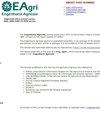使用遥控飞机(rpa)图像来绘制棉花作物的盈利情况
IF 0.8
4区 农林科学
Q3 Agricultural and Biological Sciences
引用次数: 0
摘要
本文的目的是利用RPA图像中的NDVI(归一化植被指数)数据,应用植被均匀带(HZs)划定方法来绘制棉花(Gossypium sp.)的盈利能力。研究了位于巴西巴伊亚州西部地区FAU(103公顷)和FRP农场(106公顷)的两种灌溉棉花作物。NDVI影像分为植物活力“高”、“中”、“低”3个区域;采用k-均值聚类方法。在每个HZ中,测量了产量,并估计了盈利能力。在FAU中,我们发现HZ的NDVI值越低,其盈利能力越低,因为“高活力”HZ的利润为829.40 ha-1,而“低活力”HZ的损失约为-1.256.09 ha-1(与“高活力”相比-251.44%)。在玻璃钢人工林中,NDVI值越低,人工林的损失越低,因为所有的HZ都存在损失:从“高”到“低”的HZ,盈利能力的百分比差异为-343.43%。因此,在RPA上使用低成本改进型近红外佳能S100能够绘制作物盈利能力图,有助于寻找产量变化背后的因素。本文章由计算机程序翻译,如有差异,请以英文原文为准。
USING REMOTELY PILOTED AIRCRAFT (RPA) IMAGERY TO MAP THE PROFITABILITY OF COTTON CROPS
The goal of this paper was to apply a method for the delineation of vegetation homogeneous zones (HZs) to map the profitability of cotton ( Gossypium sp.) using NDVI (Normalized Difference Vegetation Index) data from RPA imagery. Two irrigated cotton crops, at the FAU (103 ha) and FRP farms (106 ha), located in the western region of Bahia State, Brazil, were studied. The NDVI images were classified into three HZs: “high”, “medium” and “low” plant vigor; using the k-means clustering method. In each HZ the yield was measured, and the profitability estimated. In FAU we found that the lower the HZ’s NDVI values, the lower its profitability, because there was profit in the “high vigor” HZ, of US$ 829.40 ha-1, and loss in the “low vigor” HZ, of about US$ ‒1.256.09 ha-1 (‒251.44% compared with the “high vigor”). In the FRP plantation, the lower the NDVI values, the lower the loss of the plantation, as there were losses in all HZs: from “high” to “low vigor” HZ, the percentage difference in profitability was ‒343.43%. Thus, the use of a low-cost modified near-infrared Canon S100 on an RPA enabled the mapping of crop profitability, aiding the search for the factors behind yield variability.
求助全文
通过发布文献求助,成功后即可免费获取论文全文。
去求助
来源期刊

Engenharia Agricola
Agricultural and Biological Sciences-Agricultural and Biological Sciences (miscellaneous)
CiteScore
1.90
自引率
20.00%
发文量
62
审稿时长
6 months
期刊介绍:
A revista Engenharia Agrícola existe desde 1972 como o principal veículo editorial de caráter técnico-científico da SBEA - Associação Brasileira de Engenharia Agrícola.
Publicar artigos científicos, artigos técnicos e revisões bibliográficas inéditos, fomentando a divulgação do conhecimento prático e científico na área de Engenharia Agrícola.
 求助内容:
求助内容: 应助结果提醒方式:
应助结果提醒方式:


